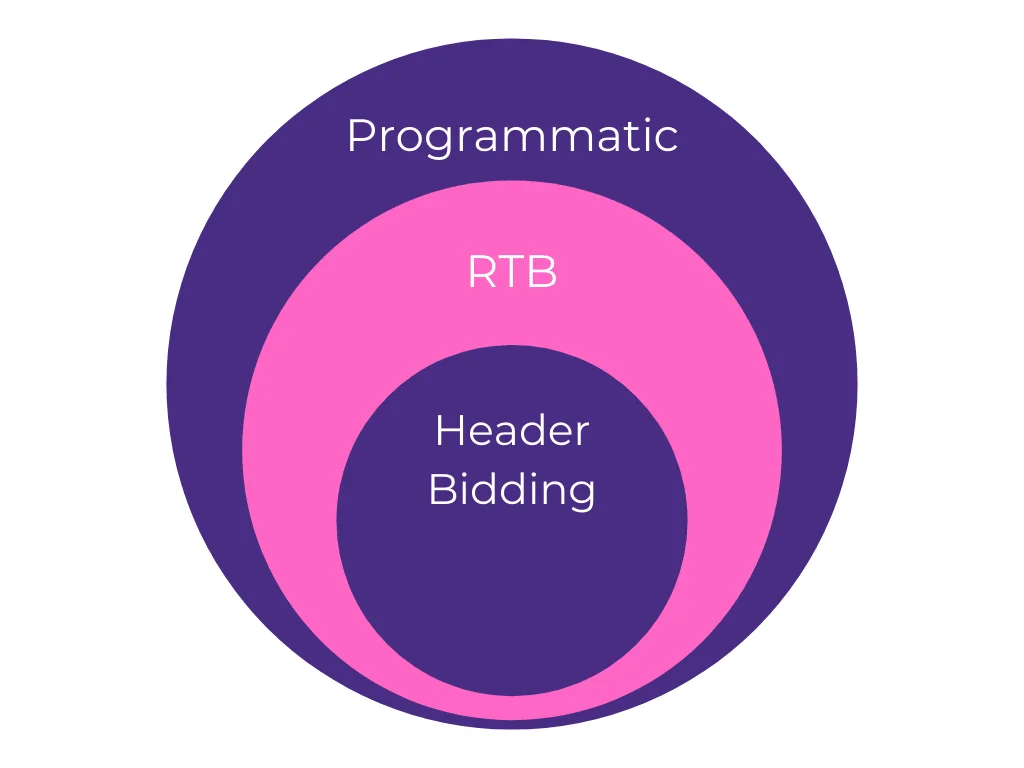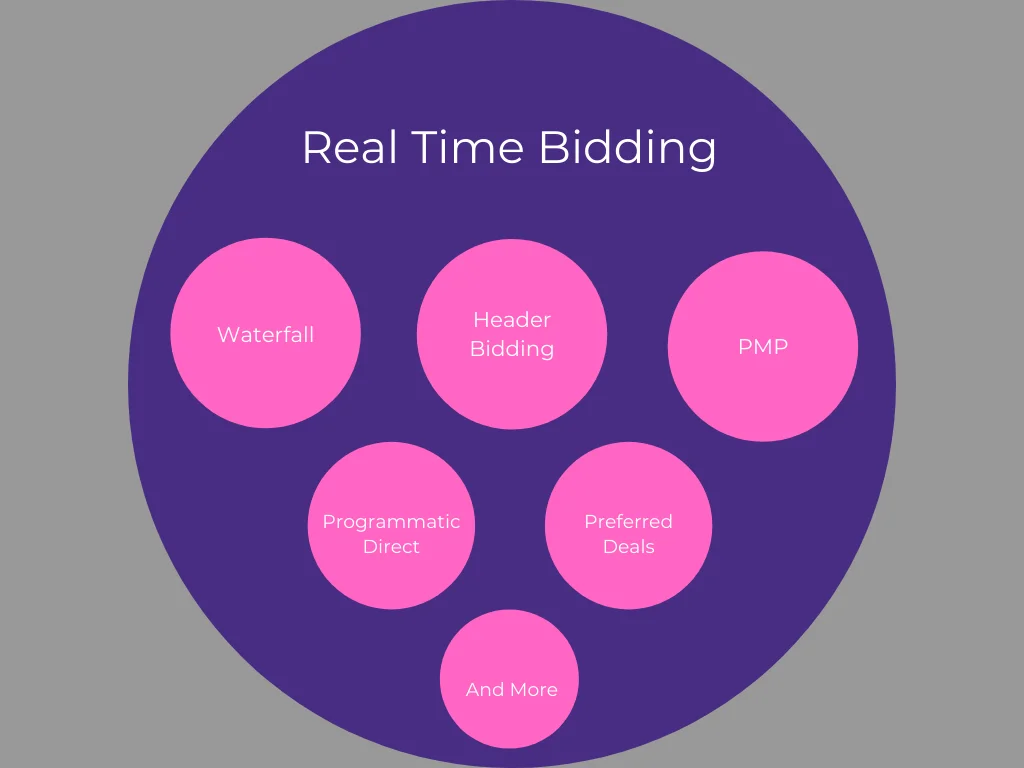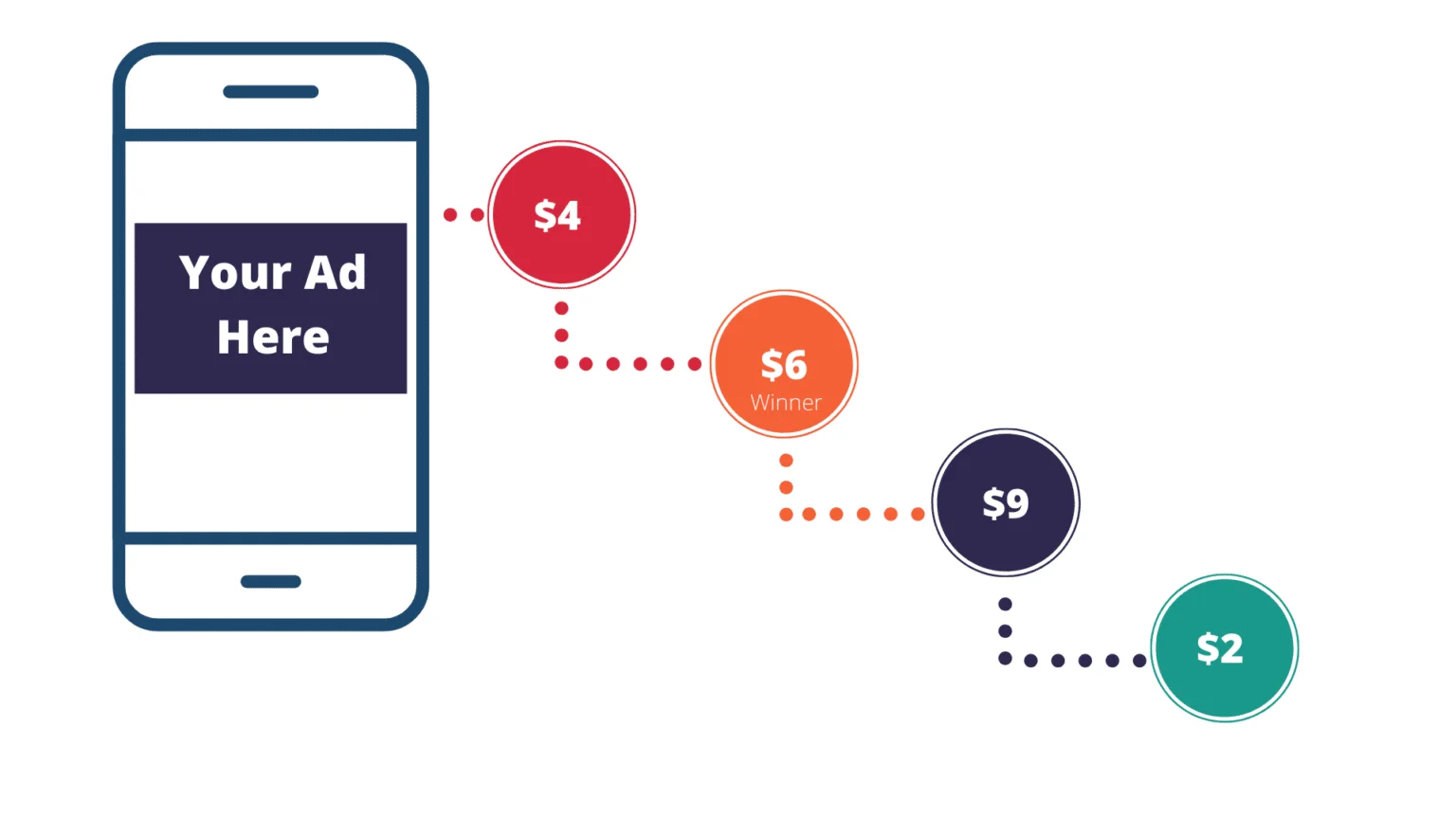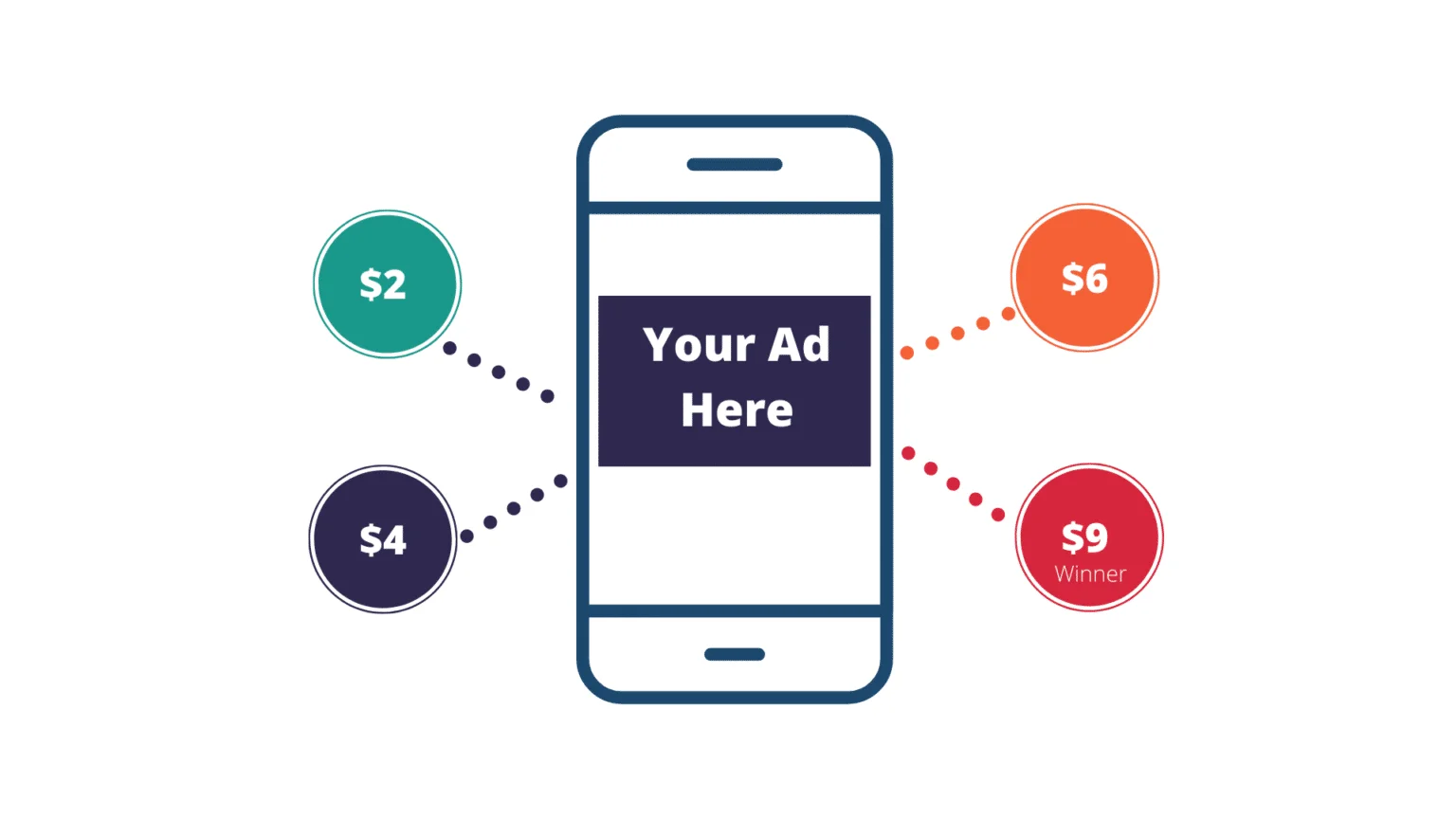Some people use the term ‘real-time bidding’ and ‘programmatic buying’ interchangeably. Others may say that header bidding is real-time bidding. Many others will say that header bidding is programmatic advertising. Confusing right? Yet interestingly, none of these statements are completely wrong. But there are still some differences. In this post, we’ll be clarifying the difference between header bidding and real-time bidding.
Before we start, have a look at the Venn diagram below.

Header Bidding is a subset of real-time bidding and real-time bidding is a subset of programmatic advertising. Please note, header bidding is not the only subset of RTB, neither is RTB the only subset of programmatic ads, we’re just keeping things simple here so that it’s easy to understand.
Sidenote: You may ask what is programmatic buying? Programmatic refers to an automated way of procuring or selling ads using technology. The process is not fully automated, it requires some amount of manual interventions too.
Table of Contents
What is Real-time Bidding?
Real-time bidding is a mechanism for buying and selling ad impressions through auctions. The mechanism is very similar to stock exchange auctions. In the stock exchanges, the traders buy and sell stocks in real-time based on various pieces of information that signal towards the increase in the stock price. Similarly, in ad exchanges, advertisers and publishers buy and sell impressions based on various pieces of information that signal towards the success of their ad campaigns.
In the stock market, the buying and selling decision is based on information like news, industry forecasts, the company’s previous performance, etc. In ad exchanges, the buying or selling decision is based on the interest of the user who’ll see the ad, the user’s previous interaction with the advertiser’s ad, demography, geography, etc.
The process is called ‘real-time’ because it starts as soon as a user begins loading the webpage and ends within milliseconds as the ad is delivered after the page is loaded. The term ‘bidding’ shows that multiple advertisers will be placing their bids simultaneously to win the impression and the winner will deliver the ad.
Here’s a theoretical example of real-time bidding in its simplest form:
A male user in the age group of 25-30 years is opening a webpage on a news site. The data associated with the user shows that he is interested in fashion, grooming, and technology. The user has also recently visited the product page of an e-commerce website where he was about to buy a book. The available data makes the user an ideal customer for an apparel business, a business that sells hair trimmers, a smartphone company, and the e-commerce website where the user was just about to purchase a book.
Now the advertisers or the agencies working for these businesses would want to show their ads to the user. But since the ad slots on the page are limited, they have to bid the amount they are ready to spend to show the ad to the user. The bids will be made and the highest bidder delivers the ad.
Why Real-time Bidding?
Before the advent of real-time bidding, online advertising was neither so targeted nor so easy. In the initial days of the internet, advertisers used to directly contact the publishers to run their ads. It was just like the traditional newspaper ads.
The impressions were sold on a CPM basis by the sales team of the online publishers. But soon the number of publishers started to increase and buying impressions directly became impractical. A huge part of publishers’ inventory started to remain unsold.
Then came the ad networks that purchased the unsold (remnant) inventories from multiple publishers at bulk and sold them to advertisers. Although the ad networks helped publishers in selling their remnant inventory, a considerable chunk of the total inventory was remaining unsold.
The advertisers were also unable to target the required number of users through a single ad network. To counter this problem, the publishers started selling their inventory to multiple ad networks and the advertisers started to buy impressions from more than one ad network too.
As a result, ad networks caused the same problem that they wanted to solve. Both publishers and advertisers now had too many ad networks to deal with. Advertisers had no strong targeting criteria as well.
The above problem was later solved by the ad exchanges during 2007/2008. They gave the publishers a place to sell their complete inventory and the advertisers could also buy every impression based on their targeting criteria. Now that the advertisers were able to buy a more targeted inventory, they were ready to spend more and the publishers were able to earn more from their inventory.
How is Real-time bidding Used?
The mechanism of real-time bidding started to pick up and then the industry started using it in multiple ways. In the beginning, the auctions were conducted in order like a waterfall where bids were placed in a sequential manner(the second advertiser couldn’t bid until the first advertiser was done, and so on). Later RTB evolved and now we have Header Bidding, Private Marketplaces, Programmatic Direct, Preferred Deals, Video Player Bidding, etc that use RTB in different ways.

What is Header Bidding?
Header Bidding is one of the methods to auction the inventory through real-time bidding. It enables publishers to send bid requests to multiple ad exchanges and other demand partners simultaneously.
Why Header Bidding?
After the arrival of RTB and before the introduction of Header Bidding, there were still many inefficiencies in the auction process. The bid requests from the advertisers were not simultaneous. The bidders were arranged in a waterfall-like sequence. The top bidders used to be at the top of the sequence followed by the lower ranking bidders. So, the lower-ranking bidders were unable to bid when the bid-request first came to the top-rankers.
Here’s an example,
The publisher sets a floor price, say $5 CPM. The bidding starts, the bid request goes to the first buyer. The first buyer bids $4, the floor price is not met so the request reaches to the second buyer. The second buyer bids $6, the floor price is met, hence the impression is sold. If the second buyer couldn’t win then the request would’ve been sent to the third buyer and so on.
The sequential setup itself was the cause of many shortcomings like:
- Even if the lower-ranking bidders would’ve been ready to bid more than the top ranking bidder for a certain impression, it wouldn’t be able to do so if the top-ranking bidder wins the impression. See the image below and observe the bid from the third buyer. Despite being the highest bid, it’s not winning the impression because it’s already been sold to the second bid:

- The lower-ranking buyers were bidding for sub-par inventory most of the time because they were not getting the chance to bid in the beginning.
- Then there were other issues like latency, lack of transparency, Google’s first look advantage, etc.
So how did header bidding solve the problem with a waterfall? It simply flattened the process. Instead of sending the bid request sequentially, publishers can now send the bid request to multiple buyers simultaneously. Due to the change in the process, the buyer with the highest bid wins the impression and publishers get the revenue they deserve.

Header Bidding vs Real-time Bidding: What’s the difference?
Header bidding is a part of real-time bidding, so it doesn’t make sense to differentiate between them. Just like real-time bidding brought improvements to programmatic buying, header bidding was an improvement to RTB. You can read more about header bidding on our blog. If you’re a publisher looking for header bidding or any other RTB implementation, then feel free to contact us.
| Real-time Bidding | Header Bidding | |
| 1 | It’s a part of Programmatic Buying. | It’s a part of real-time bidding. |
| 2 | It improved the process of programmatic buying. | It improved the process of real-time bidding. |
| 3 | It solved the inefficiencies of selling inventory in bulk to multiple ad networks. | It solved the inefficiencies of the waterfall model. |
| 4 | It provided better targeting. | It provided increased revenue for publishers and better targeting for media buyers. |
| 5 | The latency in serving ads is higher as the bidding can be sequential. | The latency in ad serving decreased once simultaneous bidding started. |
| 5 | Bidders had to wait for their turns. | No waiting was needed by the bidders. |
| 6 | Lower revenue for publishers. | Higher revenue for publishers. |
| 7 | It was ideal only for remnant inventory. | Even premium inventory can be sold for higher rates. |























